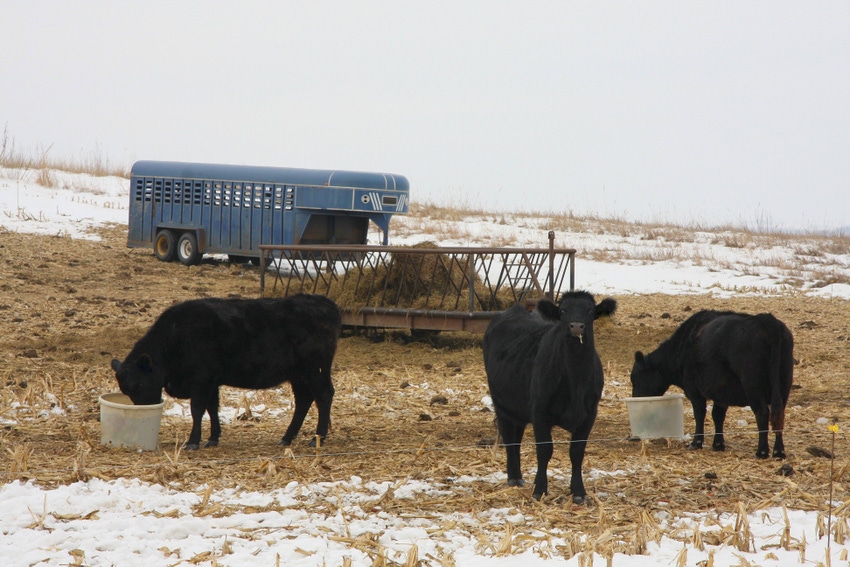Mineral supplementation is one of the most important nutritional strategies for winter. Here’s a look at a few myths and the facts that debunk them.
November 21, 2019

1. Cows know what minerals they need
Cows, like people, have no inherent knowledge of their nutritional needs, particularly when it comes to minerals. Cows will seek salt, but that does not translate to an understanding of mineral requirements. Since cows can’t read, they have no way of learning what their mineral requirements are during the production cycle, thus they depend upon us to provide appropriate mineral supplements.
Likewise, offering cows a buffet of minerals to pick and choose what they want doesn’t work. Multiple individual minerals set out for free choice consumption has never worked. In that scenario, cows will select minerals based on palatability, not necessity; so, whichever mineral disappears is the one that had more salt and tasted best.
2. Cows don’t need minerals all the time
Granted, there are some minerals that can be stored in the body to supply future demand, but several important minerals are not stored long-term in sufficient amounts. The cow does not have a mineral gauge on her side letting us know when her mineral status is low and needing supplementation.
Consider this, minerals are used every day in normal metabolism and several important processes; having a ready supply through regular consumption is important. So how do you know which days the cow does not need minerals? Additionally, transient mineral shortages can have some profound negative effects on offspring through fetal programming.
3. Cows will consume just the right amount of mineral supplement
Cows can’t read the mineral tag that informs what the expected and/or formulated consumption should be. If left to their own devices, cows will consume loose trace minerals supplements based on satisfying their salt craving/tolerance, liquid supplements based on intake controls, or hand-fed supplements based on accessibility. Relying on bovine self-control is a good way to spend too much on mineral supplements or have inadequate mineral intake.
4. Trace mineralized salt blocks are mineral supplements
Look at the tag on the product, the primary ingredient is 97 – 99% salt. Therefore, the amount of other minerals contained in the block is too little to matter. The color of the block; red, blue, yellow etc. is created to give the illusion that some mineral is included in a sufficient amount.
5. Mineral form doesn’t matter
Formulation does matter, because the different forms of minerals have different bioavailability. In general, mineral bioavailability from greatest to least is as follows: organic sources > hydroxyl, > chlorides > sulfates > carbonates > oxides. The specific order of bioavailability often depends on the specific mineral in question. The form of mineral affects mineral solubility, stability, absorption, interactions/antagonisms, and oxidation/reduction potential.
6. Grass provides all the minerals the cow needs
Forages are often deficient in multiple mineral concentrations required by cattle. Various forages types will have different mineral concentrations. Forage mineral concentrations do vary throughout the forage growing season. Soil fertility and fertilization programs can affect forage mineral concentrations.
7. You must have white salt in addition to the mineral
If the mineral supplement contains salt, the addition of more white salt only serves to dilute the formulated mineral supplement and will reduce the intake of these key minerals. In either case, the salt displaces mineral consumption, which can lead to inadequate intake of key trace minerals.
Many producers claim that if the cows consume the salt and not the mineral it is justification that the cow has adequate mineral status. Refer to myth #1. Cows will consume salt to satisfy their salt craving, and will consume either source of salt, block or loose mineral supplement, to obtain salt. Salt mixed into loose trace mineral supplements is used to both encourage and limit mineral consumption, but additional salt is not warranted.
8. The higher the inclusion the better
Putting more of a mineral in a supplement just to increase the concentration in the supplement does not always equate to a superior product. Greater inclusion rates without appropriate balancing of other minerals can lead to interactions and antagonisms that undermine the effectiveness of the mineral supplement. Also important is the form of the minerals included, see myth #5. A lot of a low-bioavailability mineral is just more product that will get excreted, not more mineral into the cow.
9. Mineral supplementation fixes everything
Undoubtedly mineral supplements are crucial to optimal cow performance. However, even the best formulation, consistently offered and adequately consumed mineral supplement, can’t fix everything. If the cows are deficient in dry matter, energy, or protein intake, are in poor health, or have inferior genetics, the productive output of these cows will be substandard.
10. There is a perfect mineral supplement out there
Often producers are looking for their next mineral supplement, because they believe something better or cheaper is available. There are some well-formulated mineral supplements manufactured by any number of companies.
However, just because a supplement is new, different, or the neighbor uses it does not mean that it will be the best option for your operation. Differences in forage base, supplemental feeds, cow breed, and stage of production all influence the appropriateness of the mineral supplement.
Hersom is a beef specialist at the University of Florida. Source: University of Florida, which is solely responsible for the information provided and is wholly owned by the source. Informa Business Media and all its subsidiaries are not responsible for any of the content contained in this information asset.
You May Also Like



